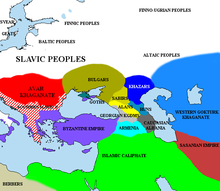Kubrat

Kubrat (also Kuvrat ) was in the 7th century ruler of the Proto-Bulgarians . The empire he founded became the nucleus of the later Greater Bulgarian Empire . He belonged to the Bulgarian ruling dynasty Dulo .
Life


According to the Bulgarian Prince List, all that is known about his life is that he ruled for 60 years and died between 641 and 668. According to a Bulgarian legend, he spent his youth in Constantinople , where he befriended the later Byzantine emperor Herakleios and adopted Christianity. Under Kubrat, the Bulgarian tribes ( proto- Bulgarians, including Kotrigurs , Unigurs [who are often viewed as Onogurs ], Old Hungarians) in the area between the Kuban and the Sea of Azov joined together to form a Greater Bulgarian Empire between 623 and 636 and broke away from the suzerainty of the Avars. At the head of the empire stood Kubrat and at his side a council of the great Boilen (see Boljars ) was established.
In 634 Kubrat made an alliance with the Eastern Roman emperor Herakleios and fought at his side against the Persians . For his services in warding off the Persian threat, he received the title of Patricius ( Patrikios ) from the Byzantine Emperor in 635 . After the death of Emperor Herakleios in 641, Kubrat supported his widow Martina and her children in the fight for the throne.
In 635 Kubrat led a campaign against the Avars. The Avars were defeated and Kubrat was able to include further areas of the Kotrigurs, who lived between the river Dniester and Pannonia and under the rule of the Avars, in his Greater Bulgarian Empire. In 648 Kubrat successfully moved against the Arabs advancing through the Caucasus Mountains under Caliph Uthman ibn Affan .
The rule of Kubrat was also known for the religious tolerance and the coexistence of ethnic religions (especially Tengrism , which worships the sky god Tengris), Buddhism , Islam and Christianity . The military, which also provided for the recruitment of young women in critical times, also received special respect. The army, which mainly consisted of mounted troops, included a light cavalry (as with all equestrian peoples of the steppe) and a heavily armed cavalry, whose warriors and horses were specially protected with iron armor.
He ruled the empire from its capital, Phanagoria .
After his death in 665, his five sons divided the empire and the population, according to legend against the wishes of Kubrat. The fact is that the eldest son Batbajan stayed in Phanagoria and Knjaz became the Bulgarian, but later he had to submit to the Khazars . The second eldest son, Kotrag, moved north and founded the empire of the Volga Bulgarians . The third oldest son, Knjas Asparuch , moved to the southwest, where he founded the Danube-Bulgarian Empire . The youngest sons Alzek and Kuver moved west with part of the people and became vassals of the Avar khaganate. All of these empires continued to bear the name of Bulgaria.
In 1912, near the Ukrainian village of Mala Pereschtschepyna (Russian: Малое Перещепино) near Poltava, a grave of a ruler with more than 800 gold (approx. 25 kg) and silver (approx. 50 kg) gifts from the 7th century was found ( treasure by Mala Pereschtschepyna ). Some of the items indicate that it must have been a Christian ruler. In 1983, the Austrian Byzantinist Werner Seibt (Byzantinist) deciphered two of the rings on which the name "Kubrat" and "Kubrat Patricius" were written in ancient Greek. Since then, some archaeologists (including Joachim Werner ) assume that it is the grave of Kubrat. The majority of the find is now kept in the Hermitage in Saint Petersburg .
Kubrat Knoll , a hill on Livingston Island in Antarctica, has been named after him since 2005 .
- See also: List of rulers of Bulgaria and the main items Proto-Bulgarians , Bulgarian history , Volga Bulgaria
literature
- Friedhelm Winkelmann u. a. (Ed.): Prosopography of the Middle Byzantine period . 1st department. Vol. 2, Walter de Gruyter Verlag, Berlin 2002, p. 634.
- Walter Pohl : The Avars . 2nd updated edition, Munich 2002.
- Günter Prinzing : Kubrat . In: Lexicon of the Middle Ages . Vol. 5, Col. 1558 (with literature).
Web links
- Khan Kubrat's Bulgarian Gold in Ukraine. A conversation with Prof. Joachim Werner (excerpt from the newspaper "Македония", edition 51-52, December 21, 1994) (Bulg.)
- The gold of Khan Kubrat in the Hermitage in Saint Petersburg ( Memento from August 22, 1999 in the Internet Archive ) (eng.)
| predecessor | Office | successor |
|---|---|---|
| - |
Bulgarian ruler 632–665 |
Batbajan |
| personal data | |
|---|---|
| SURNAME | Kubrat |
| ALTERNATIVE NAMES | Kuvrat; Kurt |
| BRIEF DESCRIPTION | Khan of the Bulgarians |
| DATE OF BIRTH | 6th century or 7th century |
| DATE OF DEATH | 665 |
